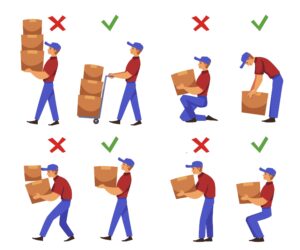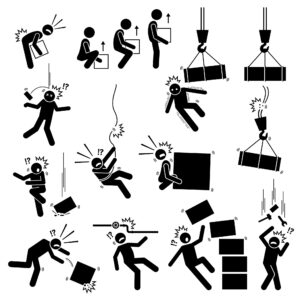Welcome to our FAQ guide on manual handling claims. In this guide, we address some common questions around claiming for manual handling accidents in the workplace. We look at the duty of care employers owe to their employees, the laws that govern this and how failures to uphold this duty can lead to accidents where employees suffer injuries.
You can also find information regarding the relevant legislation, detailing the steps employers can take to ensure manual handling tasks are carried out safely, and that the risk of manual handling injuries taking place is removed or reduced as much as is reasonably practicable.
We have also included some illustrative examples to demonstrate how an employer’s negligence regarding manual handling can lead to an accident where an employee suffers injuries. Towards the end of this guide, we explain in more detail how a manual handling risk assessment is conducted.
You can contact our advisory team at any time using the contact information given here. In addition to answering any questions you may have, they can provide a free consultation regarding your eligibility to begin a manual handling claim. Speak to them today via:
- Phone on 0161 696 9685.
- Contact us through our online form to have your claim for a manual handling accident assessed.
- Click the live chat icon at the bottom of your screen to chat about your manual handling claim.
Browse Our Guide
- What Are Manual Handling Accident Claims?
- What Percentage Of Accidents Are Caused By Manual Handling?
- Who Is Liable For Manual Handling Claims?
- What Are The 4 Considerations Of Manual Handling?
- How Often Should Manual Handling Training Be Given?
- What Are The Causes Of Manual Handling Injuries?
- Is It A Legal Requirement To Have Manual Handling Training?
- What Legislation Applies To Manual Handling?
- How Do You Carry Out A Manual Handling Risk Assessment?
What Are Manual Handling Accident Claims?
Manual handling claims are personal injury claims made following an injury caused by a manual handling accident in the workplace. Not all manual handling accidents that cause injury will mean the employee is eligible to make a personal injury claim. The accident for which the employee is claiming for must have occurred due to the negligent actions of the employer for which they suffered an injury
Manual handling is defined by the Health and Safety Executive, the national regulator for health and safety in the workplace in Britain, as the transporting or supporting a load by hand or bodily force. It can include lifting, pulling, carrying, pushing or moving loads. Loads can be objects, people or animals.
The Manual Handling Operations Regulations 1992 impose requirements on employers to mitigate the risks posed by manual handling operations as far as is reasonably possible. When employers fail to take the necessary safety measures, manual handling injuries can occur. We will explore how an employer could fail to ensure safe operations, as well as the specific obligations under the 1992 Regulations further on in the guide.
Our advisors have considerable experience in assessing manual handling injury claims. You can reach them 24 hours a day via the contact details given above to ask any questions or to get a free assessment of your eligibility to claim.
What Percentage Of Accidents Are Caused By Manual Handling?
The Health and Safety Executive HSE collates and reports on workplace safety incidents. Under the Reporting of Injuries Diseases and Dangerous Occurrences Regulations 2013, RIDDOR certain reportable workplace incidents and injuries must be reported to and recorded by the HSE.
According to the Summary Statistics for Great Britain 2023 from the Health and Safety Executive, there were 561,000 self-reported non-fatal workplace injuries through the Labour Force Survey (LFS). 60,645 non-fatal injuries were reported by employers under RIDDOR in the same period.
Of those 60,645 employer-reported incidents, 17% were manual handling injuries, making manual handling accidents the second most common cause of workplace injuries after slips, trips and falls.
Who Is Liable For Manual Handling Claims?
Under the Health and Safety at Work etc. Act 1974, employers owe a duty of care to their workforce to take reasonable steps to ensure their safety. To fulfil this duty employers could ensure that staff are trained adequately on how to do their jobs safely, provided with the correct personal protective equipment PPE when needed and ensure that not only job tasks are risk assessed but the workplace and the employee is too.
Other steps under Section 2 of the 1974 Act include ensuring the systems of work are adequately maintained, the working environment and equipment are also well maintained as far as is reasonably practicable to ensure safety and without risk to health.
Manual Handling Injury Claim Criteria
The eligibility criteria to begin a manual handling claim are given here:
- Your employer owed you a duty of care at the time of the accident.
- They failed to uphold this duty of care.
- This failure resulted in an accident in which you were injured.
As well as showing negligence on the part of your employer, any claim also needs to be brought within the relevant time limit. Per the Limitation Act 1980, there is a limitation period of 3 years from the accident date imposed on personal injury claims. Under certain conditions, such as where the injured person is a minor or of a reduced mental capacity, extensions to the general limit can be granted.
In these scenarios, it is possible for a suitable adult to apply to be a litigation friend and bring the claim on the injured person’s behalf. To get more advice on the limitation period for personal injury claims or to enquire as to whether any exceptions apply to your potential claim, speak to one of our advisors using the contact information provided in the introduction.
What Are The 4 Considerations Of Manual Handling?
The HSE routinely publish extensive health and safety guidelines concerning the safe conduct of manual handling tasks. If hazardous manual handling cannot be avoided, your employer needs to assess the risk of injury for the manual handling operations. The 4 factors that need to be considered are as follows:
- The nature of the task itself.
- The load type and weight.
- The ability of the individual carrying out the task.
- The work environment.
Dangerous manual handling practices can arise when employers fail to adequately run risk assessments. You could be eligible to make a manual handling compensation claim if your employer’s negligence has resulted in you becoming injured.
To get your eligibility to begin a manual handling injury claim assessed, contact our advisors today. You can also enquire further about the manual handling claims process for no charge.
How Often Should Manual Handling Training Be Given?
As mentioned above, all employees completing manual handling operations need to be provided with sufficient training. While there are no set rules on how often manual handling training should be provided, the HSE has issued guidance on what this training should entail.
Manual handling training should be specific to the job and needs to cover:
- The risks involved and how injuries could be sustained.
- How to use mechanical aids and other systems.
- Good handling technique and how to carry out operations safely.
- Work systems that are relevant to the workplace tasks and environments.
- Practical work so the employer can identify and rectify any issues.
Manual handling claims could be made if an employer has not provided adequate training to staff and thus caused an injury. Contact our advisors today for a free assessment of your eligibility to claim compensation for manual handling injuries in the workplace.
What Are The Causes Of Manual Handling Injuries?
A manual handling accident can occur in a number of different circumstances. You can see a few relevant examples here:
- Your employer had neglected to carry out the necessary maintenance checks on the company pump trolleys. You were using one of these trolleys to move goods when the wheels seized. This resulted in you slipping and falling, causing a knee injury as well as a sprained ankle.
- You had not been given sufficient manual handling training and consequently tried to lift a load that was well above the recommended maximum weight. You consequently dropped the heavy load while attempting to place the box onto a shelf, resulting in a broken foot.
- A water leak had been reported, but your employer had failed to carry out the repair in a reasonable time. No warning signs had been placed in the interim. You slip on the wet floor while carrying goods from storage to the shop floor as you were unable to see the hazard due to the boxes being above eye level. You sustained injuries to your head and lower back in the fall.
This is a non-exhaustive list aimed to provide guidance on when you could be eligible to begin a manual handling compensation claim. For an in-depth assessment of your eligibility to begin a manual handling injury claim in your particular circumstances, call the number below today.
Is It A Legal Requirement To Have Manual Handling Training?
Yes. Under the 1974 Act training is required if it is needed for the employee to carry out their work safely and without risk to their health. That said not all employees will need manual handling training if they are not required to carry out manual tasks.
A lack of manual handling training can increase the risk of an accident occurring. In order to uphold their duty of care, employers should ensure that workers conducting manual handling operations have received suitable training and instruction on how to carry out these tasks safely.
What Legislation Applies To Manual Handling?
While the Health and Safety at Work etc. Act 1974 details an employer’s duty of care more generally; the Manual Handling Operations Regulations 1992 detail the specific requirements employers must follow concerning manual handling operations.
The Regulations require that employers:
- Avoid hazardous manual handling operations where possible.
- Assess the risk of any hazardous manual handling that cannot be avoided.
- Reduce the risk of a manual handling injury as far as is reasonably practical.
Avoiding manual handling operations can include using automated measures. Conveyor belts, forklift trucks or robotics can all be implemented to move loads.
Where manual handling is unavoidable, employers are required to reduce the risk of injury to their workers to as low as is reasonably practical. As well as using automation and lifting aids where possible, workers should receive sufficient manual handling training with regard to the safe lifting and carrying of loads.
The working environment should also minimise the risk of a manual handling injury. Trip hazards such as uneven floors or trailing wires should be removed, or warnings posted where this is not possible.
When an employer fails to uphold the legislative requirements placed upon them by the Regulations, this can constitute a breach of their duty of care. Employees could begin manual handling claims if a breach of this duty has resulted in them becoming injured. To learn more about your eligibility to begin an accident at work claim, talk to our team today.
How Do You Carry Out A Manual Handling Risk Assessment?
There are a number of factors that need to be considered when completing a manual handling risk assessment.
The first of these is whether or not the need for manual handling at work can be be minimised or removed altogether, such as through automated or mechanical lifting aids. If these systems can be put in place, the risks of a manual handling injury from using those systems likewise need to be assessed.
Where manual handling cannot be avoided, employers should consider risks arising from the following factors; the task being performed, the load being carried, the working environment, the individual capabilities of the workers, the pace, frequency and duration of the manual handling work and how that work is organised and allocated.
With regard to specific workers, consideration should be made to any disabilities, the knowledge and experience of workers, pre-existing injuries and any language barriers. The level of detail needed in a risk assessment will vary from workplace to workplace, although the HSE has issued more in-depth advice in their guidance on manual handling.
Could I Make A No Win No Fee Manual Handling Compensation Claim?
You can contact our advisory team at any time using the contact information given here. As well as addressing your concerns regarding claiming for manual handling injuries, they can assess your eligibility to claim for no charge. If they can see that you have grounds to make a manual handling claim they could connect you to a No Win No Fee solicitor from our panel.
If a solicitor agrees to work on you manual handling claim they will do so under the terms of a Conditional Fee Agreement CFA. This is a type of No Win No Fee arrangement. This means no fees needed upfront for the solicitors work and if the claim fails still no need to pay them for the work they have done on you manual handling accident claim.
If you claim compensation successfully they will take a legally capped percentage from the compensation you are awarded.
Speak to them today via:
- Phone on 0161 696 9685
- Contact us through our online form to have your claim for a manual handling accident assessed
- Click the live chat icon at the bottom of your screen to chat about your manual handling claim.
Further Resources
You can read more of our workplace accident claims guides here:
- Learn how specialist No Win No Fee manual handling claims solicitors can help you with this guide.
- Neck injuries are a risk when employers do not follow manual handling guidance. Learn who could be eligible to begin a neck injury claim here.
- This guide examines the manual handling claims process in greater detail.
We have also included these links to external resources you may find useful:
- Employers with 10 or more employees are required to keep a workplace accident book. Read the HSE guidance on reporting accidents on this webpage.
- Repetitive lifting, carrying and pulling actions can increase the risk of employees developing back pain. The NHS has published this guidance on easing back pain and when you should seek medical attention.
- Workplace CCTV can be very useful evidence in showing how an accident took place. Read more about your right to request CCTV footage of yourself with this government resource.
Thank you for reading this FAQ guide on manual handling claims. Our advisory team is available 24/7 to answer your questions about claiming for manual handling injuries.
They can also offer a no-cost consultation regarding your eligibility to begin an accident at work claim. You can reach an advisor 24 hours a day via the contact details provided above.






